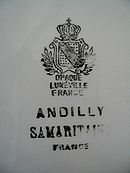The Faïencerie de Lunéville - Saint-Clément is the heir to the prestigious earthenware of Lorraine since the 18th century : Lunéville and Saint-Clément . The Lunéville factory, which was founded around 1730 , while that of Saint-Clément was founded around 1758 , was in operation until 2022.
Historical
The origin of the factory can be identified in 1711, the year when (Jean)-Jacques Chambrette père (1683-1751), a master earthenware maker from Dijon, created a first earthenware factory in Lorraine in Champigneulles on behalf of the Count of Fontenoy. In 1722, the history of earthenware began in Lunéville when his son, Jacques Chambrette (1705-1758), established himself there as an earthenware merchant. In 1723, he became a supplier to the Court. It was not until 1729 or perhaps 1730 that Jacques Chambrette fils opened his first earthenware factory there. However, he did not obtain his official letters patent until by Duke Francis III allowing him to take land and wood wherever he wanted, then the by Élisabeth-Charlotte d'Orléans , exemptions from charges and taxes.
At the same time, in 1739, Jacques Chambrette joined forces with a certain Daix to take over the Portieux glassworks .
After having developed on the one hand in 1748 the Terre de Pipe (with chalk or calcareous marl, firing white) - a secret composition which would be transmitted by one of his grandsons to the Faïencerie de Niderviller - then the Terre de Lorraine (with lime phosphate), earths giving a fine and white earthenware which allowed the obtaining of delicate details, - a technique coming from England to imitate porcelain, reason for which it is sometimes called "opaque porcelain" -, as well as on the other hand finer and polychrome decorations thanks to firing in a muffled oven called "Réverbère" ( small fire ) - a German invention from Meissen -, Jacques Chambrette had the refinement of his new productions noted to Voltaire , to his friend Émilie du Châtelet and to King Stanislas Leszczynski , the latter then granting him new letters patent on , with the right to draw its land from all unenclosed areas of Lorraine, and subsequently the authorization to the distinction of Royal Manufacture . This development allowed to increase exports to Germany, Poland, Italy and even the colonies. In 1753, there were already around 200 workers working there.
However, to avoid the heavy taxes on exports to France (from the Duchy of Lorraine), Jacques Chambrette created a second factory in Saint-Clément after requesting King Louis XV in 1756 (official authorization obtained on ), this village being located on the lands of the Three Bishoprics .
On the death of Jacques Chambrette in 1758, his son Gabriel (1732-1788) and his son-in-law, Charles Loyal (husband of Françoise Chambrette, 1730-1778), took over the two factories of Lunéville & Saint-Clément. However, this alliance was short-lived and in 1763, Charles Loyal bought the one in Saint-Clément withRichard Mique and Paul-Louis Cyfflé , while Gabriel Chambrette kept the one in Lunéville.
Two royal factories
In the middle of the 18th century , the Lunéville factory produced the earthenware of the Lunéville court . The factories were separated for more than a century.
The Saint-Clément factory
Richard Mique then developed a "Louis XVI" style, notably by supplying 2,000 pots to the queen to decorate the Petit Trianon in 1785, before being guillotined in 1794 with his son. He also made neoclassical statuettes. Paul-Louis Cyfflé sold him some of his molds following his collapse around 1780. In 1806, Madame Mique received an honorable mention at the exhibition of industrial products for her "terre de pipe" earthenware.
From 1816, the earthenware factory gradually became part of the Thomas family's heritage, which continued the tradition of artistic earthenware throughout the 19th century . It won a gold medal at the Exhibition of French Industrial Products in 1844. It then took part in the 1855 Universal Exhibition in Paris, then in the 1878 Universal Exhibition, also in Paris, where the factory exhibited all of its expertise, which attracted Émile Gallé in particular. However, it was no longer a success, which forced the factory to be put up for sale. It was bought in 1892 by the Keller & Guérin earthenware factory, its former parent company.
The Lunéville factory

The factory, run by the heirs of J. Chambrette, who at the time manufactured common tin-bearing earthenware, faced serious financial difficulties, particularly due to export taxes to France. It was put up for sale when it had only about twenty workers left. It then became the property of Sébastien Keller in 1786 (which would be the basis of the future Keller and Guérin association - a company name from 1812 - whose brand, K & G, is known worldwide and will remain linked to the Manufacture Royale de Lunéville ).
Technical evolution
In 1787, Sébastien Keller acquired the so-called "plaster" mills on the Vezouze , which prepared the raw materials. The wood-fired ovens were then replaced by coal-fired ovens in 1853. Transfer decoration appeared at the same time.
The first steam engine was installed in 1869. Production therefore became industrial after 1870, - although the factory was occupied until 1873 by the Germans following the war of 1870 - while retaining an artistic workshop in which the Nancy sculptor and ceramist Ernest Bussière collaborated. In 1887, electricity appeared at the factory.
Social evolution
Alongside these technical developments, the factory developed an avant-garde social policy: in addition to a workers' city, it offered preventive care, a mutual aid and retirement society, a purchasing cooperative, etc. This did not prevent the development of a strong union movement (following the Law on the creation of professional unions of 1884, known as the Waldeck-Rousseau law). In 1888, it employed around 1,300 workers.
Expansions and mergers
1892 was therefore the year of reunification of the two manufacturers which then dominated the French market under the aegis of Keller & Guérin.
In 1922, Édouard Fenal, son of the founder of the Badonviller earthenware factory and future mayor of Lunéville - as was his predecessor at the head of the earthenware factory, Edmond Keller - acquired the Lunéville - Saint-Clément factories and relaunched artistic production. The group then made a takeover bid in 1978 for theSarreguemines earthenware factory and continued both the specific production of each style of earthenware as well as artistic production.
In 2006, Faïence et Cristal de France , owners of the Niderviller earthenware factory , the Vallérysthal crystal factory and the Portieux crystal factory, also took possession of the Lunéville-Saint-Clément earthenware factories. A new group that perpetuates the know-how of Lorraine's fire arts was born: Terres d'Est . After more than two centuries of activity, the emblematic earthenware factory of Lorraine was put into receivership, amid general indifference.
Stylistic characters
The Lunéville
At the beginning of the 18th century , the shapes were very sculpted, taken from those of goldsmithing, similar in this to the productions of the Pont-aux-Choux Manufactory . The sculptors were therefore renowned: thus, it was Nicolas Pioche who made the statue of the dwarf Bébé in 1747.
The factory also specializes in faux marble decorations, including garden vases commissioned by Leopold I of Lorraine . Discoveries in mineral chemistry around 1750 also made it possible to launch decorations with soft colors - notably Cassius purple - thanks to the low-fire process produced in ovens using the principle of reverberation. This allowed the launch of the so-called "Réverbère" collection, known for its delicate tulips and roses, often on fretted plates highlighted with blue or purple combed patterns. This collection is still marketed today and is sometimes called "Vieux Strasbourg". It was John Fitzgerald Kennedy 's second dinner service. Around 1765, the Chinese decoration appeared, often accompanied by butterflies, which has also been marketed for two hundred and fifty years. Jean Pillement served as inspiration for this decoration. This period (1760-1780) also saw the flourishing of the somewhat Germanic rocaille style, planters decorated in the "Pompadour-Watteau" style and statuettes by Paul-Louis Cyfflé in Lorraine clay, including a famous kiss in the style of Jean-Honoré Fragonard and Jean-Antoine Houdon .
In 1806, Mr. Keller received an honorable mention at the 1806 industrial exhibition at the Hôtel des Ponts & Chaussées, then a gold medal at the 1823 Paris exhibition. The superiority of the products is due to the antiquity of the factory, since ceramics is as much an art as a science and continuous experimentation leads to improvement.
Shortly afterwards, Auguste Majorelle did his apprenticeship there: he would later market pieces made from 18th century molds from Lunéville, decorated by him, which Auguste Friedrich Demmin would not hesitate to call "counterfeits".
At the end of the 19th century , Baron Maurice de Ravinel , a relative of the Kellers by marriage, set up an art workshop at the factory, which was particularly interested in flamed stoneware and effect enamels. Ernest Bussière, Edmond Lachenal and then Louis Majorelle introduced the concept of Art Nouveau and provided him with numerous plant-inspired models, before the art workshop was closed after about ten years, probably due to lack of profitability.
The Mougin brothers - sons ofXavier Mougin , director of the Portieux crystal factory - subsequently relaunching the art workshop which had been put on hold before the First World War, would bring the factory into the Art Deco period. They would be followed and accompanied by decorators and sculptors such as Geo Condé , Geo Maxim, Émile Bachelet , Desbarbieux, Thomas Cartier ... Georges Chevalier (who would also be artistic director of the Baccarat crystal factory ) created the first artistic models for the Maîtrise ( Galeries Lafayette ) in 1921: the Chinese dancer and the doe . The Mougin brothers would thus confirm the reputation of the earthenware factories, in particular thanks to the success of sales to the various art workshops of the department stores (Primavera, Pomone, la Maîtrise ...) during the Art Deco period.
Today, at auctions, decorative pieces signed by an artist can fetch several tens of thousands of euros, while an 18th century plate will fetch a few hundred euros.






